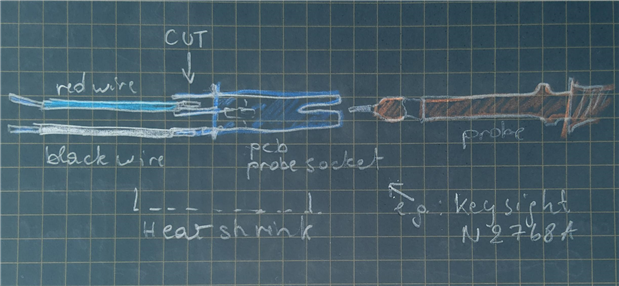It's sometimes hard to probe a point on a PCB.
Manufacturers sell "consumable" solder-in solutions.
You can temporarily or permanently attach them to your design, and it makes probing easier and reliable.
I have a suggestion for a DIY solder-in solution that takes little effort and is cheap + reusable:
Needed:
- Vertical Mini Probe Socket, Keysight Infiniium Series Oscilloscopes
- Two short ends of single stranded wire
- A bit of heat shrink or isolation tape
source: keysight
How to Make:
- Cut one of the ground pins away
- Take a short piece of black and red single strand wire (what you use on your breadboard). Remove a small end of isolation at both ends.
- Tin all the ends.
- Solder the red wire to the middle pin
- Solder the Black wire to the remaining outside pin
- Apply heat shrink to avoid shortcuts when the device rests on the PCB. Don't overdo it, so that you can remove it later when the wires are worn out.
How to use:
Solder the two wires to the desired component in the circuit.
Typically, you'll want to solder the black one to ground, the red one to the point of interest.
If you're careful, you can solder this in many times. If needed, cut away a little end of the wire and you are set for many future uses.
Insert the probe, without hook and crocodile wire attached.
Why?
- Keeping probes fixed is difficult. Once you have 2 probes in your hand and have to adjust a button, you are in trouble.
- If you keep the 2 wires short, this is a decent probing technique. Way better than the crocodile ground loop and hook.
- It's so cheap that, when you are working long time on a design, you can leave this in your prototype.



Top Comments
-

ajcc
-
Cancel
-
Vote Up
+7
Vote Down
-
-
Sign in to reply
-
More
-
Cancel
Comment-

ajcc
-
Cancel
-
Vote Up
+7
Vote Down
-
-
Sign in to reply
-
More
-
Cancel
Children